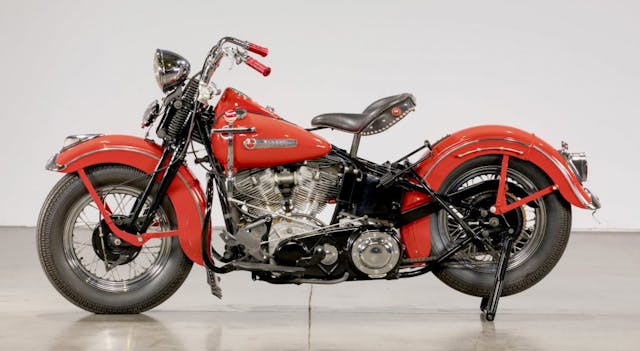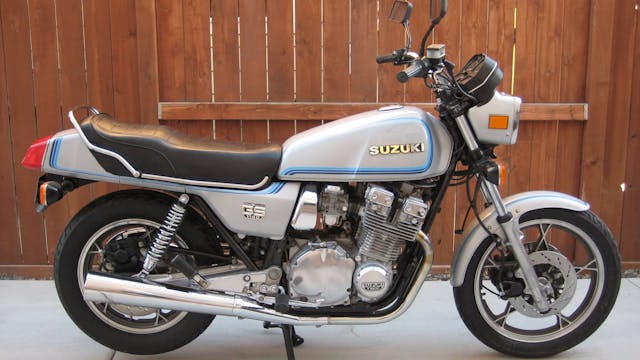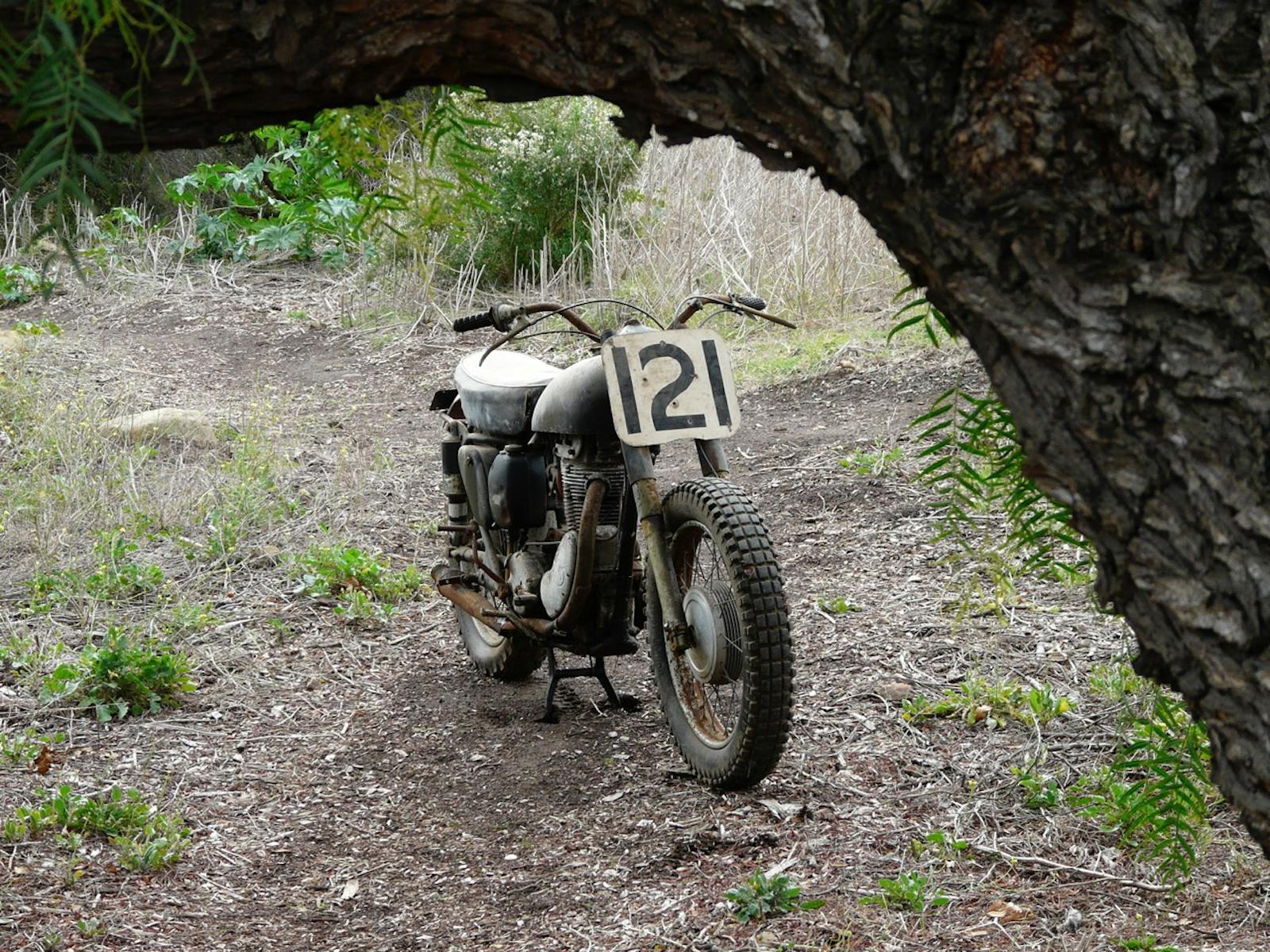4 underappreciated motorcycles cruising under the radar
As money moves around in the motorcycle world, there are models that get skipped over. With more buyers jumping into the collector motorcycle world and investors and speculators snagging up anything they think will be worth more tomorrow, it’s easy to think that all the good buys are gone. As a Hagerty valuation analyst and resident motorcycle collector, I don’t think so. There remain segments of all markets that present relative affordability and value for the dollar. In the collector car world, the motorcycle stands out.
Let’s look at four that have us wondering why they’ve lagged behind.
1948 Harley Davidson Panhead

The Harley Knucklehead gets all of the hype of the ’40s Harleys and sits near the top of the “I want one” lists of most enthusiasts, whether they’re motorcycle collectors or not. The fat tires, lopey idle, and beefy powerplant would set the style and character for every Harley that followed. Knuckleheads have seen big increases in value as buyers have moved in from all areas of the collector world, with the first-year Knucklehead’s 1936 #1 value approaching $200K and the last 1947 model’s #1 value nearing $100K. The model that superseded the Knucklehead, the Panhead, has seen less of a spike, but buyers are still shelling out handsome sums for Panheads.
The Panhead, built from 1948–65, also defined an era of Harley. The model saw the introduction of telescopic forks in the Hydra-Glide, rear suspension in the Duo-Glide, electric starting, and hydraulic brakes, and all of these developments set it apart visually from the iconic Knuckle look—all but the first year of the Panhead, which was visually similar to the iconic Knucklehead. It sits in a rare middle ground between the 1949 Panhead Hydra-Glide that got telescopic forks and the 1947 Knucklehead with the springer front end. Having the same aesthetics of the Knuckle—largely the reason why so many non-motorcycle collectors want Knuckle art for their collection—and being a one-year-only model, one would expect the ’48 Panhead value to sit fairly evenly between the Knuckle and later Panhead. This is not the case, and buyers seem to overlook the ’48 for what it offers. Hagerty sees nearly half as many quotes for the ’48 Panhead as the ’47 Knucklehead.
Despite losing the quintessential early Harley look, the 1949 Hydra-Glide maintains a #2 value of $37,100 versus the 1948 FL Panhead’s #2 value of $42,000. This is only 12 percent less than the first-year Panhead. On the other hand, the ’48 is 31 percent less than a 1947 Knucklehead with a #2 value of $61,000. I wouldn’t be surprised if the first-year Panhead enters the mainstream collector world and soon sees more eyes outside of devoted Harley fans.
1996–99 Moto Guzzi Daytona RS

Name a sporty red Italian motorcycle that makes a thundery exhaust note and has a slightly concerning rattle coming from the engine … and it isn’t a Ducati. That might leave you a bit stumped, but Moto Guzzi is the brand I’m looking for. It’s the Ducati brand recognition that does a lot for values on those bikes, and as people hear that sportbikes are heating up (literally, a Ducati will burn your bum), they gravitate towards brands they know as desirable. Most people aren’t going to think of Moto Guzzi, let alone the Daytona RS from the late ’90s. This helps keep values reasonable to the point where you can get a rare model that is the pinnacle of Moto Guzzi’s sportbike technology for the price of a base Ducati 916.
Italian bikes have always had a loyal following, good or bad, and generated feelings in riders that other bikes do not. This is where the Daytona shines. It is not the fastest. It does not handle the best. It does not have the most modern technology. What it does give you is one of the most enjoyable and vocal riding experiences you will ever experience. Compared to performance Ducati bikes of the era, such as the Ducati 916, the Daytona provides a bargain. Compared to lesser loved Ducatis of the era, such as the 888 and 900 Super Sport, it is an absolute steal.
A 1996 Ducati 916 base model has a #2 value close to $10K, and a rare homologation 916 SPS model has a #2 value close to $20K. A standard 1993 Ducati 900 Super Sport’s #2 value of $8200 puts it alarmingly close to far more rare and sporty bikes, like the Daytona RS. The Daytona RS engine features upgrades such as forged pistons, Carrillo rods, and lightened fly wheel, and it puts more focus on the engine than other Guzzi 1100s that are already a bike built around an engine. With nice examples to be had for $10K—the price of a base Ducati 916 and 50 percent less than a 916SPS—it’s hard to see why the Daytona RS does not get the love that the Ducati does. Maybe it will soon?
1976–77 Honda GL1000 Gold Wing

When the words Gold Wing are mentioned in the motorcycle world, people immediately think of massive touring bikes with large fairings and radios ready to cross the country. Twice. In one week. The first, short-lived generation of the Gold Wing from 1975–77 had no fairing and no radio, and big touring bikes didn’t exist, but in order for the big-fairing touring bike segment to exist, someone had to build it. Honda set off to win this category with a bike for “America,” and the first Gold Wing was born.
There was nothing like it at the time. It featured a flat-four engine, last produced in the ’30s by Zundapp, that was extremely smooth and could run for hours and hours at speed. It was certainly a heavy bike at close to 600 pounds—over 100 pounds heavier than a CB750 and 125 pounds heavier than a BMW r90/6—but it wore its weight low and had over 30 horsepower more than both bikes. The GL1000 quickly proved to be extremely reliable and riders took them all over the country, and it is one of the only bikes of the era where it is common to find for sale with over 50,000 miles and ready for 50,000 more. It can cruise at modern highway speeds reliably 45 years later, and do it with a lot more style than later touring bikes.
There was no segment for it at the time, and once owners started putting large Vetter fairings, radios, and luggage racks to tour the country, it quickly spawned the full fairing touring bikes that were to come. Honda had a hit and knew what the future was. This “confused” demeanor at the time meant it was not a superbike and it was not a cruiser Harley, and this holds it back in a collector world that focuses heavily of CBs in the mid-’70s. Collectors have started to look towards the early GL1000s more and more in recent years, though, with bikes like the first-year 1975 GL1000 and ’76 GL1000 Limited seeing huge appreciation, but the ’76 and ’77 GL1000s have escaped large value increases for all but the finest bikes. This means one can still pick up a running model for near $1000, or a good example for around $3000, and that entry point for such a reliable and usable motorcycle is hard to find from that era anymore. You won’t get the same deal when buying a CB750, which has a #2 value 41 percent higher than the Gold Wing or the BMW R90/6. A good condition example will cost you 45 percent more.
1980–83 Suzuki GS1100E

Suzuki was one of the last to hang on to the hope that two-strokes would remain competitive in the street-bike market, with the GT750, but in 1977 it came around and hit a home run with the GS750 (its first four-stroke, more than 20 years after Honda). Being the last to market meant it was the most modern, though. It had all the updates the CB750 was yearning for and handled better than the Yamaha XS750 and Kawasaki Z1. Then Suzuki one-upped it and released the GS1000 in 1978. Yoshimura, the famed racing team and tuning company, quickly switched from Kawasaki to Suzuki for 1978, and Wes Cooley would go on to win the 1979 and ’80 AMA Superbike Championship on the GS1000S.
With all Suzuki learned from the GS1000 it released the GS1100, and the hottest of them all was the GS1100E that features a 16-valve head. It would go on to win the acclaimed superbike of the year Cycle World award from 1981–83. The Honda CBX or CB1100F were comparable in magazines at the time and are two bikes that get huge accolades in the collector bike world today. When compared to the CBX, the GS is faster (it was the fastest bike to complete Cycle World‘s quarter-mile test at the time). It has more horsepower than the CBX throughout the rev range. It is more than 50 pounds lighter, and it handled better—fun fact though, the CBX has more cornering clearance than the GS1100 despite two more cylinders sticking out either side (Thanks, engineers). The GS1100E is called one of the first modern supersports, and the updated 1983 GS1100ES model was faster and lighter than the CB1100f. All of those benefits for … 61 percent less than a #2 value CBX and 23 percent less than a #2 value CB1100F.
Honda and Kawasaki are kings of the inline-four (and six) naked bikes of the era, and Suzuki seems to only come into its own in the collector world with the faired sportbikes era. That leaves the early GS bikes, groundbreaking in their time, as providing incredible value, especially when looking for a bike to ride. We can all admit that a CBX engine is the best to look at and take to redline, but no one wants to sync six carbs or adjust 24 shimmed valves.
Like this article? Check out Hagerty Insider, our free e-magazine devoted to tracking trends in the collector car market.


Routine service and wear parts for early Gold Wing MCs
are apparently manufactured and distributed by the well-
known UNOBTAINIUM Company, not Honda Motors. Ask
anyone with a 1990s or older bike.